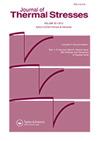Peridynamic simulation of heat transfer during quenching of semi-solid plate with occurrence of hot cracks
IF 2.6
3区 工程技术
Q2 MECHANICS
引用次数: 0
Abstract
AbstractQuenching plays an important role in the material processing. Water impingement jet quenching involves phenomena such as nucleate boiling, Leidenfrost effect, rewetting, etc. Stronger thermal gradients could induce cracks in the material. Thermal boundary conditions of the process depends on temperature, space, time, and material discontinuity. This study mainly focuses on the thermal modeling of moving water jet quenching of semi-solid hot vertical aluminum plate with latent heat release during the solidification by using Peridynamics (PD). The obtained thermal profile is compared with the infrared camera’s thermal field data to identify the boiling curve parameters on the cracked plate. The PD model with the incorporation of cracking dynamics is giving agreeable results with the experimental thermal field. Modeling quenching heat transfer using PD will enhance the coupling of hot tear origination and propagation simulation, which is quite challenging with other numerical methods. The application of PD in quenching heat transfer with phase change is the first of its kind. The advantages and limitations of the peridynamic approach for this problem is critically evaluated and the simulated results are compared with the experimental measurement of temperature profiles.Keywords: Hot cracksperidynamicsphase changequench heat transferquenchingsemi-solid state AcknowledgmentsThe authors express their gratitude to Dr. Nyein Nyein Linn (AIRTF scholar) who came from Myanmar for the short-term research training at NIT-T. We express our sincere thanks to the project students Manu Aatitya R P, Yogeesh S, and Sriranga V who helped us to develop the PD code in MATLAB.Authors’ contributionsJijo Prasad Jayaprasad Remani: Writing – Original Draft, Methodology, Investigation, Formal analysis, Visualization, Software, Validation.Saravanakumar Palanisamy: Experimental measurement and observations, Software, Validation.Ashok Kumar Nallathambi: Supervision, Conceptualization, Writing – Review & Editing, Project administration, Software.Selda Oterkus: Peridynamic formulation of heat transfer – Methodology.Daniel Juhre, and Eckehard Specht: Experimental measurement and observations – Resources, Investigation.Data availability statementThe raw/processed data required to reproduce these findings cannot be shared at this time as the data also forms part of an ongoing study.Disclosure statementThe authors declare that they have no known competing financial interests or personal relationships that could have appeared to influence the work reported in this paper.Additional informationFundingThis work is financially supported by the Science and Engineering Research Board (SERB-DST), India under the project SRG/2019/001463. OvGU Magdeburg, supported for the scholar’s experimentation under funding GRK 1554.存在热裂纹的半固态板淬火过程传热的动力学模拟
摘要淬火在材料加工中起着重要的作用。水冲击射流淬火涉及到成核沸腾、莱顿弗罗斯特效应、再润湿等现象。较强的热梯度会导致材料出现裂纹。过程的热边界条件取决于温度、空间、时间和材料的不连续性。本文主要利用周动力学(periddynamics, PD)方法对含潜热释放的半固态热立铝板的流动水射流淬火过程进行了热模拟。将所得热剖面与红外热场数据进行对比,确定裂纹板上的沸腾曲线参数。结合裂纹动力学的PD模型与实验热场的关系得到了满意的结果。利用PD方法模拟淬火传热可以增强热撕裂产生和传播模拟的耦合性,这是其他数值方法所无法比拟的。PD在相变淬火传热中的应用尚属首次。对该问题的周动力学方法的优点和局限性进行了批判性评价,并将模拟结果与温度分布的实验测量结果进行了比较。关键词:热裂纹,动力学,相变,传热,淬火,半固态感谢来自缅甸的Nyein Nyein Linn博士(AIRTF学者)来nitt进行短期研究培训。我们衷心感谢项目学生Manu Aatitya R P, Yogeesh S和Sriranga V,他们帮助我们在MATLAB中开发了PD代码。jijo Prasad Jayaprasad Remani:写作——原稿、方法论、调查、形式分析、可视化、软件、验证。Saravanakumar Palanisamy:实验测量和观察,软件,验证。Ashok Kumar Nallathambi:监督,概念化,写作-审查和编辑,项目管理,软件。Selda Oterkus:热传递的动态公式-方法论。Daniel Juhre和Eckehard Specht:实验测量和观察-资源,调查。数据可用性声明再现这些发现所需的原始/处理数据目前不能共享,因为这些数据也是正在进行的研究的一部分。披露声明作者声明,他们没有已知的竞争经济利益或个人关系,可能会影响本文所报道的工作。本研究由印度科学与工程研究委员会(SERB-DST)资助,项目编号为SRG/2019/001463。马格德堡OvGU,在GRK 1554资助下支持该学者的实验。
本文章由计算机程序翻译,如有差异,请以英文原文为准。
求助全文
约1分钟内获得全文
求助全文
来源期刊

Journal of Thermal Stresses
工程技术-力学
CiteScore
5.20
自引率
7.10%
发文量
58
审稿时长
3 months
期刊介绍:
The first international journal devoted exclusively to the subject, Journal of Thermal Stresses publishes refereed articles on the theoretical and industrial applications of thermal stresses. Intended as a forum for those engaged in analytic as well as experimental research, this monthly journal includes papers on mathematical and practical applications. Emphasis is placed on new developments in thermoelasticity, thermoplasticity, and theory and applications of thermal stresses. Papers on experimental methods and on numerical methods, including finite element methods, are also published.
 求助内容:
求助内容: 应助结果提醒方式:
应助结果提醒方式:


